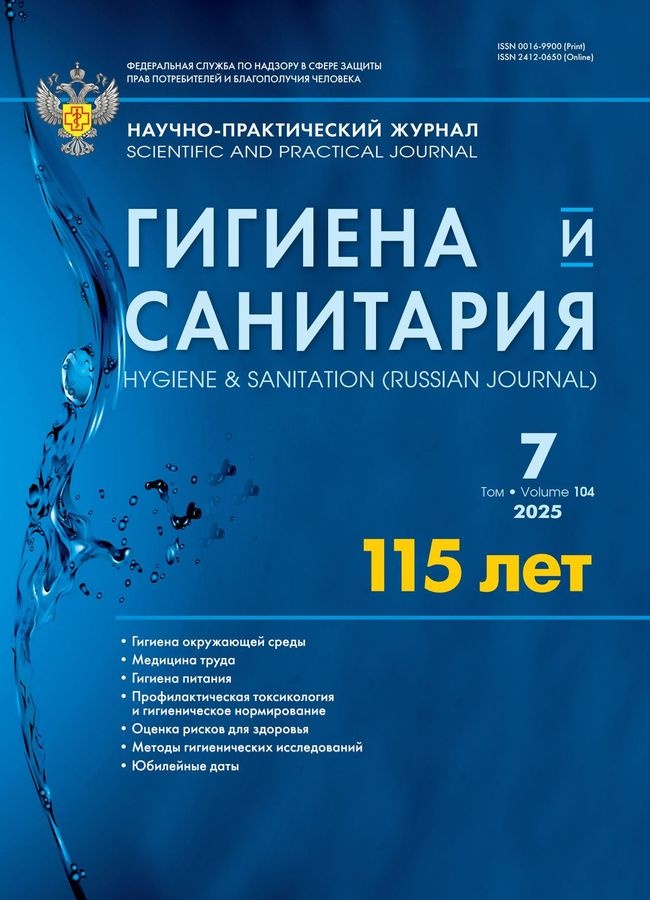The search for genetic polymorphisms associated with vibration disease
- Authors: Mukhammadiyeva G.F.1, Shaihlislamova E.R.1,2, Valova Y.V.1, Karimov D.D.1, Repina E.F.1, Yakupova T.G.1, Karimov D.O.1,3
-
Affiliations:
- Ufa Research Institute of Occupational Health and Human Ecology
- Bashkir State Medical University
- N.A. Semashko National Research Institute of Public Health
- Issue: Vol 104, No 7 (2025)
- Pages: 874-878
- Section: OCCUPATIONAL HEALTH
- Published: 15.12.2025
- URL: https://bulletin.ssaa.ru/0016-9900/article/view/691293
- DOI: https://doi.org/10.47470/0016-9900-2025-104-7-874-878
- EDN: https://elibrary.ru/ggdvrs
- ID: 691293
Cite item
Abstract
Keywords
About the authors
Guzel F. Mukhammadiyeva
Ufa Research Institute of Occupational Health and Human Ecology
Email: ufniimt@mail.ru
Elmira R. Shaihlislamova
Ufa Research Institute of Occupational Health and Human Ecology; Bashkir State Medical University
Email: fbun@uniimtech.ru
Yana V. Valova
Ufa Research Institute of Occupational Health and Human Ecology
Email: Q.juk@yandex.ru
Denis D. Karimov
Ufa Research Institute of Occupational Health and Human Ecology
Email: lich-tsar@mail.ru
Elvira F. Repina
Ufa Research Institute of Occupational Health and Human Ecology
Email: e.f.repina@bk.ru
Tatyana G. Yakupova
Ufa Research Institute of Occupational Health and Human Ecology
Email: tanya.kutlina.92@mail.ru
Denis O. Karimov
Ufa Research Institute of Occupational Health and Human Ecology; N.A. Semashko National Research Institute of Public Health
Email: karimovdo@gmail.com
References
- Мухина Н.А., Бабанова С.А. Профессиональные болезни. М.: ГЭОТАР-Медиа; 2018.
- Шайхлисламова Э.Р., Валеева Э.Т., Волгарева А.Д., Кондрова Н.С., Галимова Р.Р., Масягутова Л.М. Профессиональные заболевания от воздействия физических факторов в Республике Башкортостан. Медицина труда и экология человека. 2018; (4): 63–9. https://elibrary.ru/ypnmfv
- Бабанов С.А., Азовскова Т.А., Вакурова Н.В., Бараева Р.А. О современных аспектах классификации вибрационной болезни. Терапевт. 2019; (4): 21–7. https://elibrary.ru/zcqfgh
- Жукова А.Г., Горохова Л.Г. Ретроспектива молекулярно-генетических исследований производственно обусловленной патологии. Медицина в Кузбассе. 2020; 20(3): 5–11. https://doi.org/10.24412/2687-0053-2021-3-5-11 https://elibrary.ru/xwxgem
- Баранов В.С. Геномика и предиктивная медицина. Сибирский журнал клинической и экспериментальной медицины. 2021; 36(4): 14–28. https://doi.org/10.29001/2073-8552-2021-36-4-14-28 https://elibrary.ru/kkkzma
- Ядыкина Т.К., Коротенко О.Ю., Семенова Е.А., Бугаева М.С., Жукова А.Г. Исследование генов глутатион-S-трансфераз (GST) T1 и M1 у работников алюминиевой промышленности с коморбидной кардиоваскулярной патологией. Медицина труда и промышленная экология. 2023; 63(8): 519–27. https://doi.org/10.31089/1026-9428-2023-63-8-519-527 https://elibrary.ru/vfnyqa
- Heaver C., Goonetilleke K.S., Ferguson H., Shiralkar S. Hand-arm vibration syndrome: a common occupational hazard in industrialized countries. J. Hand Surg. Eur. Vol. 2011; 36(5): 354–63. https://doi.org/10.1177/1753193410396636
- Stoyneva Z., Lyapina M., Tzvetkov D., Vodenicharov E. Current pathophysiological views on vibration-induced Raynaud’s phenomenon. Cardiovasc. Res. 2003; 57(3): 615–24. https://doi.org/10.1016/s0008-6363(02)00728-9
- Youakim S. The validity of Raynaud’s phenomenon symptoms in HAVS cases. Occup. Med. (Lond). 2008; 58(6): 431–5. https://doi.org/10.1093/occmed/kqn075
- Hara K., Hirowatari Y., Yoshika M., Komiyama Y., Tsuka Y., Takahashi H. The ratio of plasma to whole-blood serotonin may be a novel marker of atherosclerotic cardiovascular disease. J. Lab. Clin. Med. 2004; 144(1): 31–7. https://doi.org/10.1016/j.lab.2004.03.014
- Razzaque Z., Pickard J.D., Ma Q.P., Shaw D., Morrison K., Wang T., et al. 5-HT1B-receptors and vascular reactivity in human isolated blood vessels: assessment of the potential craniovascular selectivity of sumatriptan. Br. J. Clin. Pharmacol. 2002; 53(3): 266–74. https://doi.org/10.1046/j.0306-5251.2001.01536.x
- Caimi G., Hopps E., Montana M., Carollo C., Calandrino V., Incalcaterra E., et al. Nitric oxide metabolites (nitrite and nitrate) in several clinical condition. Clin. Hemorheol. Microcirc. 2014; 56(4): 359–69. https://doi.org/10.3233/CH-131758
- Sanders A.R., Cao Q., Taylor J., Levin T.E., Badner J.A., Cravchik A., et al. Genetic diversity of the human serotonin receptor 1B (HTR1B) gene. Genomics. 2001; 72(1): 1–14. https://doi.org/10.1006/geno.2000.6411
- Zhang X., Sun Y. The predictive role of ADRA2A rs1800544 and HTR3B rs3758987 polymorphisms in motion sickness susceptibility. Int. J. Environ. Res. Public Health. 2021; 18(24): 13163. https://doi.org/10.3390/ijerph182413163
- Chotani M.A., Flavahan S., Mitra S., Daunt D., Flavahan N.A. Silent alpha(2C)-adrenergic receptors enable cold-induced vasoconstriction in cutaneous arteries. Am. J. Physiol. Heart Circ. Physiol. 2000; 278(4): H1075–83. https://doi.org/10.1152/ajpheart.2000.278.4.H1075
- Williams F.M., Cherkas L.F., Spector T.D., MacGregor AJ. A common genetic factor underlies hypertension and other cardiovascular disorders. BMC Cardiovasc. Disord. 2004; 4(1): 20. https://doi.org/10.1186/1471-2261-4-20
- Susol E., MacGregor A.J., Barrett J.H., Wilson H., Black C., Welsh K., et al. A two-stage, genome-wide screen for susceptibility loci in primary Raynaud’s phenomenon. Arthritis Rheum. 2000; 43(7): 1641–6. https://vk.cc/cOFw1C
- Chen Q., Lang L., Xiao B., Lin H., Yang A., Li H., et al. HTR1B gene variants associate with the susceptibility of Raynauds’ phenomenon in workers exposed hand-arm vibration. Clin. Hemorheol. Microcirc. 2016; 63(4): 335–47. https://doi.org/10.3233/CH-152021
- Hartmann S., Yasmeen S., Jacobs B.M., Denaxas S., Pirmohamed M., Gamazon E.R., et al. ADRA2A and IRX1 are putative risk genes for Raynaud’s phenomenon. Nat. Commun. 2023; 14(1): 6156. https://doi.org/10.1038/s41467-023-41876-5
- Wigley F.M., Flavahan N.A. Raynaud’s phenomenon. Rheum. Dis. Clin. North Am. 1996; 22(4): 765–81. https://doi.org/10.1016/s0889-857x(05)70300-8
Supplementary files









